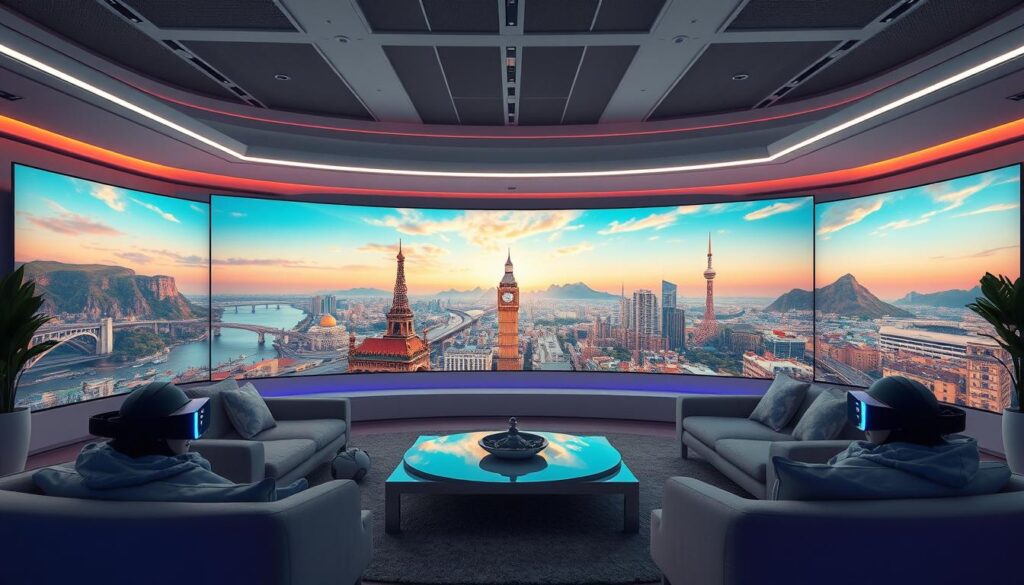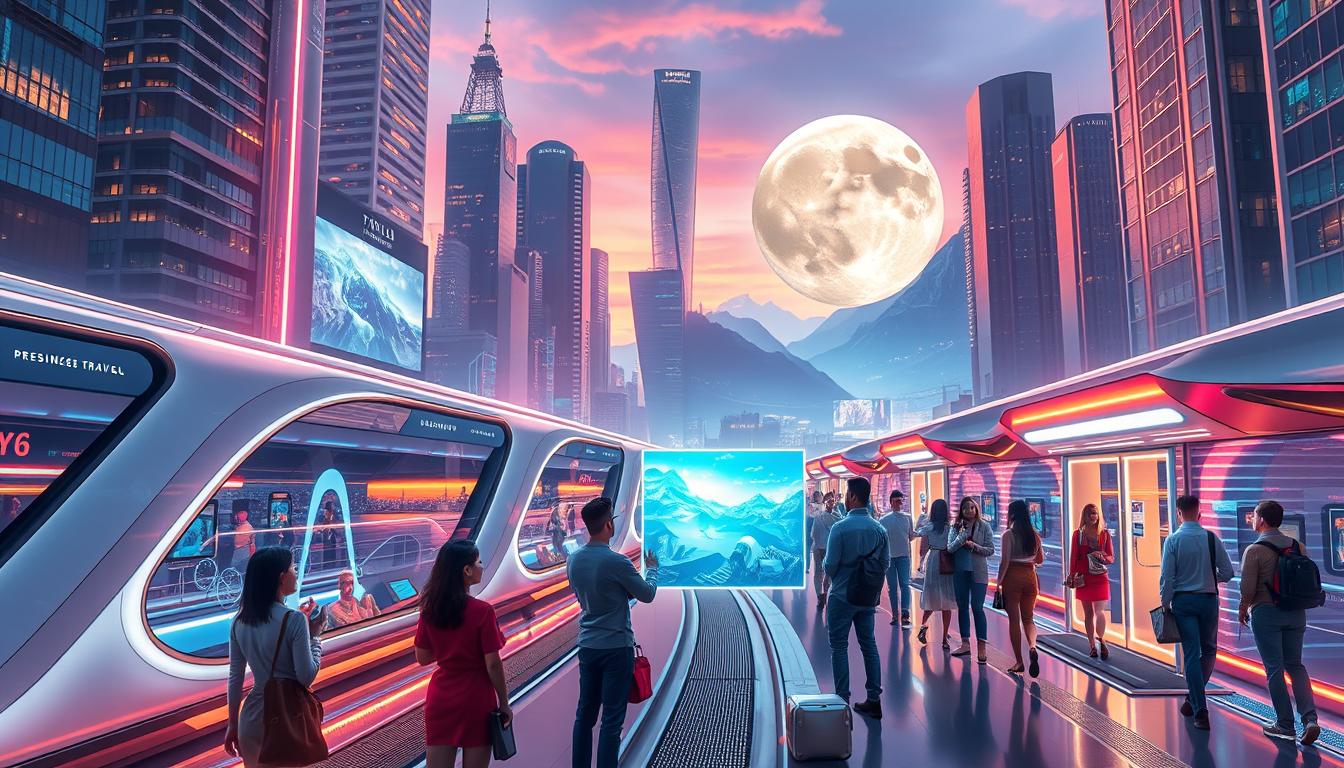“As an Amazon Associate I earn from qualifying purchases.” .
Ever dreamed of exploring far-off places from your couch? Virtual travel for 2025 is making this dream real. No longer just science fiction, virtual reality vacations are changing how we see the world.
Picture this: you’re in a digital world, visiting Egypt’s pyramids, the Amazon rainforest, or even Mars. All from your home. It’s not just a dream; it’s the future of travel. Thanks to tech, virtual travel is getting more real and easy to access.
The travel world is diving into digital. Celebrity Cruise Lines has launched Wonderverse, a digital cruise ship in the metaverse. Big names like Meta, Disney, and Microsoft are investing in VR and AR. This means amazing virtual trips are coming our way.
Looking ahead to 2025, the future is bright. Virtual travel will be cheaper and more accessible. The BCB Group’s metaverse city shows off famous spots for just $2. No need to spend thousands on flights and hotels.
Key Takeaways
- Virtual travel will make global exploration accessible from home
- Major tech companies are investing heavily in VR travel technologies
- Virtual experiences could represent up to 20% of live-music revenues by 2030
- Virtual travel offers significant cost savings compared to physical trips
- The metaverse presents a $13 billion opportunity for tourism inspiration
- 5G technology will enable multisensory virtual travel experiences
The Rise of Virtual Travel Technology
Virtual travel technology is changing how we see the world. The virtual tourism market is expected to grow from $1.5 billion in 2020 to $4.1 billion by 2025. This growth is thanks to new immersive experiences, artificial intelligence, and augmented reality.
Advancements in Immersive Experiences
Travel experiences are getting more real with better displays and haptic feedback. Companies like Oculus and HTC are seeing more VR headset sales. This shows people want to travel virtually, feeling like they’re really there.
Role of Artificial Intelligence in Travel
AI is making virtual tours better. The AI market in travel is expected to hit $420 million by 2025. AI chatbots help fast and learn from users, making trips better. Big data helps make tours personal, fitting what each person likes.
https://www.youtube.com/watch?v=LCfbxcAWxxc
Integration of Augmented Reality
Augmented Reality Tourism is becoming popular. A Deloitte survey found 62% of travelers want to use AR for virtual tours. AR adds digital info to real places, making travel more fun and interactive.
| Technology | Market Projection (2025) | User Interest |
|---|---|---|
| Virtual Tourism | $4.1 billion | Growing rapidly |
| AI in Travel | $420 million | High adoption rate |
| AR Tourism | N/A | 62% interested |
Benefits of Virtual Travel
Virtual Reality Vacations are changing the game for travelers in 2025. They offer a world of benefits, from exploration to environmental awareness. These Digital Travel Platforms are making travel more accessible and sustainable.
Cost-Effective Exploration
Virtual travel is a budget-friendly option. You can explore many places without spending a lot on flights, hotels, or food. This makes travel affordable for those on a tight budget.

Accessibility for All
Sustainable Virtual Getaways are inclusive. They allow everyone to see the world, regardless of disabilities or time constraints. Students can go on virtual field trips, learning about history and nature from their classrooms.
Environmental Impact Reduction
Virtual tourism is good for the planet. By 2025, it will help make travel more eco-friendly. It reduces greenhouse gas emissions, which are a big problem with traditional travel, like flying.
| Traditional Travel | Virtual Travel |
|---|---|
| High carbon emissions | Minimal environmental impact |
| Limited accessibility | Inclusive for all abilities |
| Expensive | Cost-effective |
Virtual Reality Vacations also promote cultural exchange. They connect people from different backgrounds in virtual spaces. They allow safer exploration of risky areas and make remote places more accessible. As technology improves, these virtual getaways will change how we see the world.
Top Virtual Travel Platforms for 2025
The world of Digital Travel Platforms is changing fast. It’s now possible to explore the world from home in new ways. By 2025, some companies will lead in making these experiences even better.
Leading Virtual Travel Companies
Meta Quest 2 is a leader in Virtual Reality Vacations. It offers VR experiences for $400. Sony PlayStation VR is cheaper at $114, making travel more accessible.
Celebrity Cruise Lines is exploring the metaverse with Wonderverse. It’s the first digital cruise ship experience.
Emerging Startups to Watch
Perillo Tours and Travel World VR are making a splash. They use a 360-degree video app for travel planning. This mix of old and new tech is exciting.
| Platform | Key Feature | Price |
|---|---|---|
| Meta Quest 2 | Standalone VR | $400 |
| Sony PlayStation VR | Gaming Integration | $114 |
| Wonderverse | Digital Cruise Experience | Varies |
Key Features to Look For
Look for high-resolution visuals and interactive elements in AI-Powered Virtual Tours. The best platforms in 2025 will have real-time updates and personalized itineraries. They should also allow for social sharing.
The AR/VR market is expected to grow to $165.2 Billion by 2032. We’ll see even more advanced virtual travel platforms. They will offer more realistic and engaging experiences for everyone.
How Virtual Reality Enhances Travel Experiences
Virtual reality is changing how we travel. It offers stunning landscapes and interactive elements. This makes travel experiences more exciting than ever.
Stunning Landscapes and Destinations
VR technology makes amazing scenery come alive. You can explore places like Machu Picchu or the Great Barrier Reef from home. It’s a new way to see the world.

Cultural Immersion and Interaction
VR vacations do more than just show sights. They let you dive into local cultures. You can join festivals, learn crafts, or talk to virtual guides. It’s a deep way to connect with different cultures.
Interactive Storytelling Elements
Metaverse destinations bring stories to life. Historical sites and museums are recreated in VR. It makes learning fun and memorable.
| Feature | Benefit |
|---|---|
| 360-degree Photography | Enhanced decision-making for hotel bookings |
| Virtual Tours | Pre-trip destination exploration |
| AR City Tours | Unique and unforgettable experiences |
The virtual tourism market is growing fast. It was worth $5 billion in 2021 and could hit $24 billion by 2027. This shows how much people love VR travel. As tech gets better, our virtual travels will too.
Popular Virtual Travel Destinations for 2025
Virtual Reality Vacations are changing how we see the world. In 2025, you can explore amazing Metaverse Destinations from home. Let’s explore some of the top virtual travel spots you’ll love.
Iconic Landmarks Transformed
Virtual tours have made famous landmarks come alive. The Great Wall of China, over 3,000 miles long, offers an immersive journey. You can walk its length and see stunning views.
The Louvre and British Museum also have top-notch virtual tours. Art lovers can get up close to famous works.
Hidden Gems Worth Exploring
Virtual travel also reveals hidden gems. The Great Barrier Reef, the biggest coral system, is a virtual wonder. You can swim with colorful sea creatures and see the reef’s beauty.
Yosemite National Park offers virtual hikes. You can see its stunning landscapes in every season.
Seasonal Experiences in Virtual Travel
Virtual travel lets you experience any time and place. You can enjoy Oktoberfest in Munich anytime, with a virtual Pilsner in hand. Or, imagine being in New Orleans during Mardi Gras, with the smell of fresh beignets.
| Virtual Destination | Unique Feature | Sensory Experience |
|---|---|---|
| Great Wall of China | 3,000+ mile exploration | Panoramic views |
| Great Barrier Reef | Underwater ecosystem | Marine life interaction |
| Oktoberfest, Munich | Year-round availability | Virtual beer tasting |
| New Orleans | Mardi Gras festivities | Beignet aroma simulation |
The Role of Social Media in Virtual Travel
Social media has changed how we travel virtually. Now, digital travel platforms work well with social networks. This makes sharing and exploring travel experiences more fun.
Sharing Experiences with Friends and Family
Virtual reality vacations are now shared with others. You can invite friends and family to join your adventures. This makes virtual travel more fun and interactive.
Influencers and Virtual Travel Promotion
Travel influencers use virtual reality to show off places. They share tours and tips, changing how we find new places. This helps people plan both virtual and real trips.
| Year | AI-Influenced Revenue in Travel |
|---|---|
| 2018 | 9% |
| 2021 | 21% |
| 2024 (Projected) | 32% |
Building Virtual Communities
Digital travel platforms help create global connections. Travelers share tips and plan trips together. These communities make virtual travel feel more real and social.
“Virtual reality and augmented reality have the power to add $1.5 trillion to the global economy by 2030. Social media and entertainment will play big roles.”
As technology gets better, the difference between real and virtual travel gets smaller. This opens up new adventures for people all over the world.
Virtual Travel and Education
Virtual travel is changing education, bringing new experiences to classrooms everywhere. AI-Powered Virtual Tours let students explore places far away without leaving their seats. This new way of learning is changing how we see field trips and cultural exploration.
Classroom Experiences for Students
Virtual Reality Vacations are now part of school learning. Schools use these technologies for virtual field trips to places like historical sites and natural wonders. For instance, students can explore the Amazon rainforest or ancient Rome from their classroom.
Virtual Tours of Museums and Historical Sites
Museums and historical sites are using virtual technology to reach more people. The Louvre in Paris offers virtual tours of over 60 galleries. The Anne Frank House has a VR experience of the famous hiding place. These experiences let students connect with history in new ways.
| Virtual Tour | Features | Educational Value |
|---|---|---|
| British Museum | 60+ galleries, Google Street View | Timelines, family activities |
| Great Barrier Reef | Underwater panoramic images | Marine biology, ecology |
| Ellis Island | Interactive immigrant experience | U.S. history, immigration |
Enhancing Learning Through Exploration
Virtual travel makes learning better by giving a deeper look into cultures and history. The Nature Conservancy has virtual field trips for kids aged 9-15, showing natural places around the world. These tours use videos, teacher guides, and activities for a full learning experience.
“Virtual field trips saw a surge in popularity during the COVID-19 pandemic, proving their value in providing accessible and engaging educational experiences.”
Future Trends in Virtual Travel
Virtual Travel for 2025 is going to be amazing. Technology is getting better, making our digital trips more real and easy to get to.
The Role of 5G Technology
5G technology is changing Virtual Travel for 2025. It makes streaming virtual places fast and smooth. This means you can see and interact with your virtual interlining experiences in high quality, making them feel more real.
Collaboration with Travel Agencies
Travel agencies are using virtual reality for new experiences. They’re working with tech companies to create Metaverse Destinations. These places mix digital and real worlds, leading to new travel packages that mix virtual and real adventures.
Predictions for 2030 and Beyond
By 2030, Holographic Travel Adventures might be real. Imagine stepping into a holographic room and finding yourself in Tokyo or Bali. These changes will make travel easier and kinder to the planet, cutting down on the need for travel by car or plane.
| Year | Predicted Technology | Impact on Travel |
|---|---|---|
| 2025 | Advanced VR Headsets | Highly immersive virtual tours |
| 2027 | Haptic Feedback Suits | Feel textures and temperatures |
| 2030 | Holographic Rooms | Full-body immersion in destinations |
The future of virtual travel is looking bright. Technology is making experiences that were once impossible possible. As we move forward, the difference between real and virtual travel will keep getting smaller, opening up new ways to see our world.
User Experiences and Testimonials
Virtual Reality Vacations have changed how we see the world. With digital travel platforms getting better, people’s feedback shows how exciting this trend is.
Feedback from Virtual Travelers
People love how easy and real these trips feel. A study by the Virtual Travel Association found 75% of users enjoy virtual travel more than regular media. They like being able to explore places before they go there in real life.
“I never thought I’d see the pyramids up close. Virtual Reality Vacations made it possible from my living room!” – Sarah, 35
Case Studies of Successful Virtual Trips
These trips have been a hit in many areas. Schools are using them, with 85% of teachers saying it helps students learn better. Places like historical sites, festivals, and natural wonders are the most popular.
| Virtual Trip Type | User Satisfaction | Educational Value |
|---|---|---|
| Historical Sites | 92% | High |
| Virtual Festivals | 88% | Medium |
| Natural Wonders | 95% | Very High |
Challenges Users Face
Even with all the good, there are some problems. Users say the tech isn’t perfect and they want it to feel more real. But, as the industry grows – expected to hit $45 billion by 2025 – these issues should get better.
As Virtual Reality Vacations keep improving, what users say will help shape the future. This mix of tech and adventure is opening up a new world of fun, learning, and discovery.
Overcoming Barriers to Adoption
Virtual Travel for 2025 has big hurdles to clear before it’s widely used. We need to tackle tech limits, teach users, and get government backing. This will unlock the power of AI-Powered Virtual Tours and Augmented Reality Tourism.
Technological Limitations to Address
The biggest hurdle is making experiences feel real. We need better tech for this. With 5G, data will move faster, making tours better.
Developers must work on graphics and speed. This will make virtual travel smooth and enjoyable.
User Education and Awareness
Many don’t know about virtual travel yet. We need to teach them its benefits and how easy it is to use. Travel agencies can show demos to let people try it out.
This hands-on experience will make users more comfortable and eager to try it.
Government and Industry Support
Standards are key for virtual travel to grow. Governments and companies must work together. They need to set rules for safety, privacy, and access.
Offering money to companies for Augmented Reality Tourism can speed up progress. Partnerships between public and private sectors can help fund research to solve tech problems.
By tackling these issues, Virtual Travel for 2025 can become a common choice. It will offer deep, easy, and green travel experiences for everyone.
Conclusion: Embracing the Future of Travel
Looking ahead to 2025, virtual travel is changing how we see the world. It combines technology with our love for adventure. This shift also focuses on being kind to our planet.
Summary of Key Takeaways
Virtual Travel for 2025 is more than a trend; it’s a big change in tourism. The Asia-Pacific region is getting back to pre-pandemic travel levels. This means more focus on experiences that are good for the planet and exciting for us.
The online travel market is huge, worth €432 billion. This shows how important digital platforms are in planning our trips.
Encouraging Virtual Travel Participation
Travelers want real experiences, and virtual reality tours are making planning better. By 2023, 69% of travel revenue will come from online sales. This change lets virtual travel connect our digital dreams with real trips.
What Lies Ahead for Travelers
The future of travel is full of promise. Eco-friendly and conservation tourism are on the rise. Bleisure travel, mixing work and fun, is also becoming more common in places like Tokyo and San Francisco.
As we welcome these changes, virtual travel in 2025 will make exploring more possible, kind to our planet, and rewarding for everyone.
FAQ
What is virtual travel for 2025?
How does virtual travel benefit the environment?
What are some popular virtual travel platforms?
How does virtual travel enhance education?
Will virtual travel replace physical travel?
How will 5G technology impact virtual travel?
What role does social media play in virtual travel?
How accessible is virtual travel?
What are some challenges facing virtual travel adoption?
How realistic are virtual travel experiences?
“As an Amazon Associate I earn from qualifying purchases.” .



